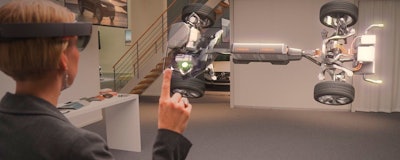
 Matthew B. Elliott
Matthew B. Elliott Fear of new technology eliminating manufacturing jobs continues to escalate, particularly when it comes to artificial intelligence and robotics. What’s missing from the discussion, however, is a look at assistive technologies, such as augmented reality (AR) and virtual reality (VR) that can create a partnership between man and machine.
Both AR and VR are improving performance, safety and design function in the manufacturing space; when paired with human labor they are becoming known as “upskilling technologies.” A recent report by Bank of America Merrill Lynch on AR/VR finds that that more than 50 percent of manufacturing organizations are testing AR given its potential to boost productivity (30 percent faster assembly), reduce costs (25 to 60 percent savings on installation and maintenance) and improve output (40 to 90 percent higher accuracy).
Here are three ways VR and AR are re-shaping the mid-market manufacturing space:
Worker Performance – AR and VR improve workers’ sight line and enable them to complete tasks more quickly. For example, a Harvard Business Review study documented a GE technician who wired a wind turbine’s control box in the traditional manner — reviewing the instruction manual, turning to the turbine, turning back to the instructions, etc. — and performing the same task while guided by line-of-sight instructions overlaid via an AR headset. The device improved the worker’s performance by 34 percent on first use.
Inspection and Maintenance – AR and VR can decrease inspection time and assist in detecting errors. Since 2011, Airbus has implemented AR technology to increase efficiency and improve quality control at its installation and inspection facilities. Using the company’s Supply Augmented Reality Tool (SART), employees can use a tablet to overlay a digital mockup over images of real systems to identify faulty parts that need to be repaired or replaced.
Product Design – Companies can also use virtual reality in the product design stage of manufacturing, allowing developers to quickly make modifications and additions before products go into modeling and manufacturing processes. For instance, in September 2017, Ford announced expanding the use of Microsoft’s HoloLens for designers. This allows designers to quickly model changes to cars, where they would previously have to develop a clay model. Using the HoloLens, designers can also overlay new features onto physical prototypes.
While the implementation of AR and VR technologies still face a few hurdles, including companies having adequate processing speeds, bandwidth and AI-analytics capabilities to fully implement the new technologies, the fact that several companies are experimenting with AR/VR is likely to nudge the industry forward in 2019. And, even though factories will continue to automate routine responsibilities, workers will remain imperative in operating robots and artificial intelligence in many non-routine tasks. With AR and VR, employees will be safer and more productive along the way.
Matthew B. Elliott serves in a dual role as Michigan Market President and as the Business Banking Midwest Region Executive at Bank of America Merrill Lynch.






















